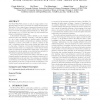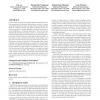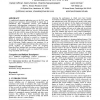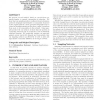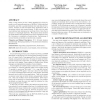WWW
2010
ACM
14 years 6 months ago
2010
ACM
The Web abounds with dyadic data that keeps increasing by every single second. Previous work has repeatedly shown the usefulness of extracting the interaction structure inside dya...
WWW
2010
ACM
14 years 6 months ago
2010
ACM
WWW
2010
ACM
14 years 6 months ago
2010
ACM
The World-Wide Web consists not only of a huge number of unstructured texts, but also a vast amount of valuable structured data. Web tables [2] are a typical type of structured in...
WWW
2010
ACM
14 years 6 months ago
2010
ACM
Online reviews in which users publish detailed commentary about their experiences and opinions with products, services, or events are extremely valuable to users who rely on them ...
WWW
2010
ACM
14 years 6 months ago
2010
ACM
As sophisticated enterprise applications move to the Web, some advanced user experiences become difficult to migrate due to prohibitively high computation, memory, and bandwidth r...
WWW
2010
ACM
14 years 6 months ago
2010
ACM
We describe Dispute Finder, a browser extension that alerts a user when information they read online is disputed by a source that they might trust. Dispute Finder examines the tex...
WWW
2010
ACM
14 years 6 months ago
2010
ACM
We propose a novel method, based on concepts from expander graphs, to sample communities in networks. We show that our sampling method, unlike previous techniques, produces subgra...
WWW
2010
ACM
14 years 6 months ago
2010
ACM
Crowdsourcing is a new Web phenomenon, in which a firm takes a function once performed in-house and outsources it to a crowd, usually in the form of an open contest. Designing ef...
WWW
2010
ACM
14 years 6 months ago
2010
ACM
In this paper we study the community structure of endorsement networks, i.e., social networks in which a directed edge u → v is asserting an action of support from user u to use...
WWW
2010
ACM
14 years 6 months ago
2010
ACM
Today, a huge amount of text is being generated for social purposes on social networking services on the Web. Unlike traditional documents, such text is usually extremely short an...

